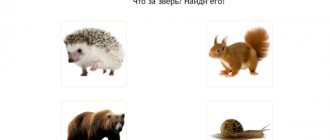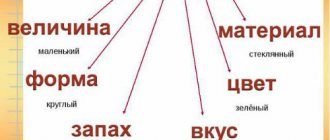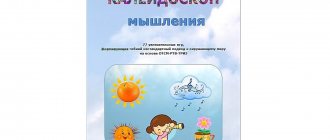Pedagogical technologies in environmental education of preschool children
The technology of organizing labor in nature is carried out in the logic of organizing the work activities of children - from familiarization with the work of an adult in caring for animals and plants to learning feasible methods of care and independent implementation of work activities in nature.
A characteristic feature of work in nature is the focus on helping a living creature or natural object, and therefore the child’s responsibility for the condition of the plant or animal in the process of care increases.
In work activity, the emphasis shifts from activities for oneself (“I water the plant so that it is beautiful and makes me happy”) to activities for another living being (“I water the plant - it needs my help”).
Most children are interested in activities in nature in which they can realize their need to communicate with living objects. For older preschoolers who have a fairly broad understanding of nature, experience interacting with it, and a high level of development of manual skills, practical activities with natural objects are quite interesting and attractive. Many children prefer it to other types of children's activities. Currently, the values of labor, including labor caring for animals and plants, are becoming expressed, and the need for basic labor activity is emerging, which children clearly lack today. Therefore, in kindergarten it is necessary to create conditions to satisfy this need and at the same time develop the practical skills of older preschoolers.
GAMING TECHNOLOGIES
An important role in children’s knowledge of natural objects is played by practical modeling actions, when the teacher depicts with his hands the shape, size, height or length of natural objects: he “draws” a round tomato, an apple, a long carrot, a large round watermelon or a head of cabbage in the air. Asks the children to do the same with their hands - movements and actions reinforce what the eyes see and what is indicated by the word.
The teacher carefully introduces the game as a method of environmental education. At this age, story play is just beginning, it is not yet the leading activity, so the teacher’s task is to select simple and familiar images, play actions and words through which the environmental content will be expressed. The best images for this purpose are the images of the fairy tales “Ryaba Hen”, “Turnip”, “Kolobok”, “The Wolf and the Seven Little Goats”, “Zayushkina’s Hut”.
The theme of domestic animals is easy to imagine with the help of Baba and Grandfather from “Ryaba the Chicken”, who, in addition to chickens, have a cow, a goat, a horse and other animals. Either Grandfather or Baba “comes” to classes, they talk about a cow with a calf, then about a goat with kids, show how they feed them with grass, hay, and water. The teacher gives the children the opportunity to participate in these operations as assistants - they feed toy (or depicted in the picture) cows and goats with hay, graze them, build barns for them, and imitate their actions and sounds. This game allows children to explore rural reality, develops their gaming skills, imagination, and consolidates their knowledge of fairy tales.
Innovative technologies for environmental education of preschool children
Nature is a great teacher! Environmental education is very closely related to moral education - this is the education of humanity, kindness, mercy, and a responsible attitude towards nature and the people who live nearby. Our task is to teach the child to treat every living organism as a valuable, unique entity that has the right to life. The best result can be achieved if you begin to form the foundations of environmental culture in preschool age.
To make every day of children’s stay in kindergarten interesting and eventful, we try to implement the tasks of environmental education through an integrated approach to teaching and use innovative technologies in our work.
A way for children to understand the world around them is through play. Role-playing is a method in which children act out a life situation. Children model their own behavior and build relationships. In role-playing games, the child’s social competencies are actively formed. We give role-playing games an ecological character: “Journey to the Forest”, “Journey to Neptune”, “Journey to the Moon”, “Zoological Store”, “Vitamin Lunch”, etc.
In our work we also use puzzle games, experiment games, research games, meditation games
(“I am Rain”, “I am Sun”, “I am Wind”, “Sun and Cloud” and others) give new impressions about the life and work of people, about the state of nature and its changes; awaken interest in nature and develop a value-based attitude towards it. Form motives and practical skills for environmentally appropriate activities; provide opportunities for independence, initiative, cooperation, responsibility and the ability to make good decisions. In these games, children use their life experience and reflect what interests, excites, and pleases them.
An interesting game technique in working with children is receiving letters of complaints from residents of a living area, residents of a forest, garden, or vegetable garden. When children receive such a letter, they think about its contents, discuss various environmental situations, decide how they can help this or that living creature, how they need to preserve and protect the nature of their land and the entire planet.
To develop in children the ability to analyze various problems and find solutions, as well as the ability to work with information, we use case technologies in our work. A technology case is an analysis of a situation or a specific case, a business game.
Case - technologies develop communicative competencies in those educational areas where there is no clear answer to the question posed, but there are several answers, and you need to find the right answer by arguing your reasons. For example, the case illustration “Does a child behave correctly in nature?”
The “Good-Bad” discussion method improves children’s knowledge about the phenomena of living and inanimate nature, animals and plants. Children are offered different situations, and they make conclusions, for example: “Why did the leaf turn yellow?”, “A lot of snow in winter - is it good or bad?”, “If all the birds on earth disappear - is it good or bad?”, “They go every day.” Is rain good or bad?”, etc. The purpose of such a case is to jointly analyze the situation, find a way out, the correct version. Business game “Who is after whom?” Shows children that in nature everything is interconnected.
Business game “What will happen if ...?” helps to learn what needs to be done in order to protect, preserve and enhance nature, develops the ability to draw conclusions and conclusions. For example: “ What happens if you don’t put out a fire in the forest? "
Business game “Take care of nature.” Invite children to look at pictures depicting plants, birds, animals, humans, the sun, water, etc. One of the pictures is removed, and the children must tell what will happen to the remaining living objects if there is no hidden object on Earth. For example: we remove a bird - what will happen to the rest of the animals, to humans, to plants, etc.
Information and computer technologies are widely used to improve and update the forms and methods of working with children.
A child, with his visual-imaginative thinking, understands only what can be simultaneously viewed, heard, acted upon, or evaluated the action of an object. This is why it is so important when teaching preschoolers to access the channels of information available to them.
Introducing children to nature, we use a variety of materials: didactic pictures, reproductions of artistic paintings, photographs, videos, sound recordings, in which children become active objects of pedagogical influence.
We use the following types of illustrative and visual materials on electronic media, such as:
1. Sound materials are recordings of the voices of birds, mammals, the noise of the forest, surf, rain, wind, etc.
2. Screen materials are slides dedicated to a specific topic.
3. Multimedia presentations are educational screensavers with beautiful, bright pictures that help teach children about the world around them. The presentation combines dynamics, sound, and colorful images, which significantly improves the perception of information.
3. multimedia environmental games both in the content of classes to get acquainted with the outside world, and in free activities: travel games, riddle games, didactic games, quizzes, physical exercises, finger games.
4. Media classes, which I conduct in a group room using a laptop or in a music room equipped with a computer, projector and screen.
An effective method of expanding knowledge on ecology is the use of pearls of folk wisdom - fairy tales, legends, sayings, riddles on environmental topics . The goal is to enrich the mind and excite the soul, and not so much to provide ready-made answers to the questions posed, but to develop the child’s ability to think independently, using his experience and previous observations: “If there is a lot of forest, don’t destroy it, if there is a little forest, take care of it, if there is no forest, plant it.” etc.
One of the forms of non-traditional environmental education for preschool children is environmental theater , which promotes the development of a sense of collectivism, responsibility, forms the experience of moral behavior, and influences the spiritual and moral development of the individual. Children reveal environmental problems through costumed theatrical performances including songs, dances, and propaganda ditties that promote environmental protection. Parents of students are involved in the organization of environmental theater. Ecological theater opens up wide possibilities for creative search, the result of which is new knowledge about our common home, about our neighbors on the planet, about the interdependence of man and nature. Ecological theater classes provide an opportunity not only to study and understand the world around us, but also to live in harmony with it.
Conducting competitions, quizzes, brain rings, entertainment and environmental celebrations, such as “What? Where? When?"; "Nature Experts"; “We are friends of nature”; "Earth Day"; "Birthday of the forest"; "Gold autumn"; “Titmouse Day” helps children feel like they are part of nature. Children are happy to perform in front of their friends, as well as in front of their parents, who are not only frequent guests, but also participants at our holidays.
Another interesting form of working with children is promotions.
In our preschool, environmental events take place throughout the school year. During the events, preschoolers receive natural history knowledge, develop environmental culture skills, and an active life position. The promotions serve as good environmental propaganda among the parent community. Children see the attitude of their parents, the organization of the event and participate in it themselves. Each action is held under its own motto and has visual propaganda (leaflets, posters, memos).
Types of actions: “Let's protect spruce and pine” ; “Feed the birds in winter” ; "Snow blanket for trees"; "Take care of the primroses" ; “Let's decorate the planet with flowers”; “Clean yard - clean planet”; “Protect the forest and its inhabitants from fire!”
As an innovative form of environmental education, we use the ecological trail .
An ecological path allows you to more productively use regular walks with children for environmental activities and at the same time for children’s health in the fresh air. The same objects can be visited many times, especially in different seasons of the year. On the path we conduct observations, games, theatrical activities, and excursions. It is very important to remember the integrated approach: on the path, the children and I observe, examine, discuss, analyze, etc., then the children express their impressions of what they saw, their acquired knowledge about nature, in different types of activities: visual, musical, which helps to consolidate this knowledge in the child’s memory.
Preschool children, with their desire to understand the world around them, present great opportunities for developing a moral position in relation to their native land. the organization of the “I want to know everything!” circle to be innovative in this work. on experimental activities, where the child is given complete freedom to demonstrate cognitive, emotional, social and motor activity in the process of experimentation.



